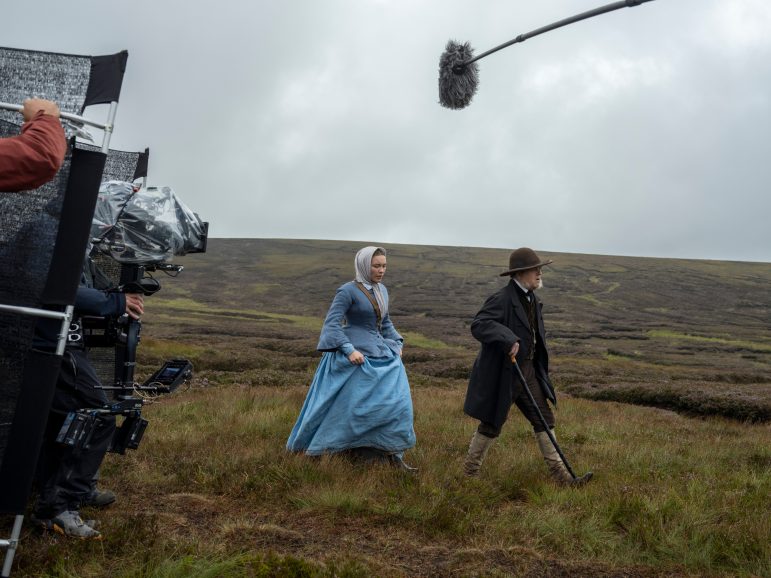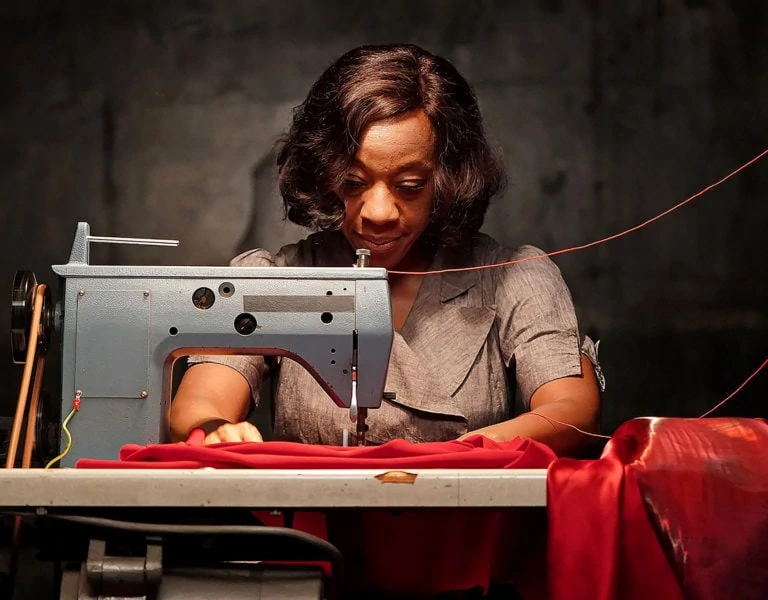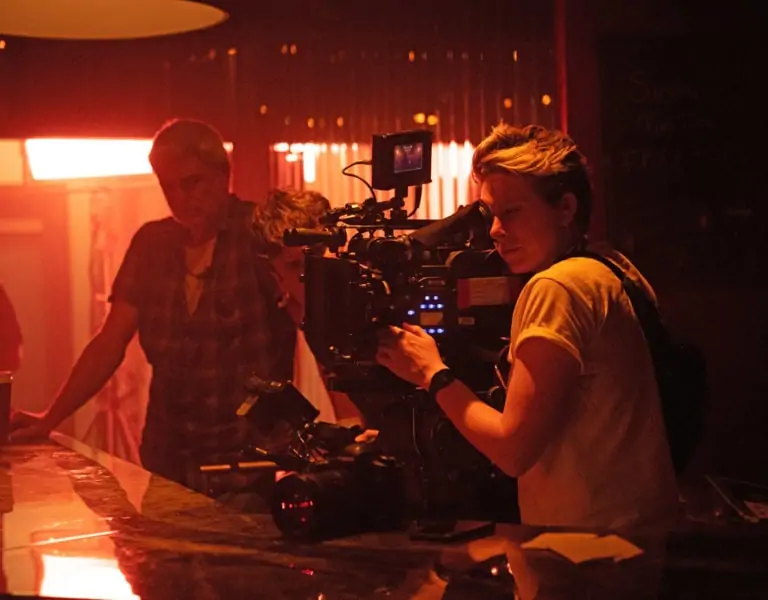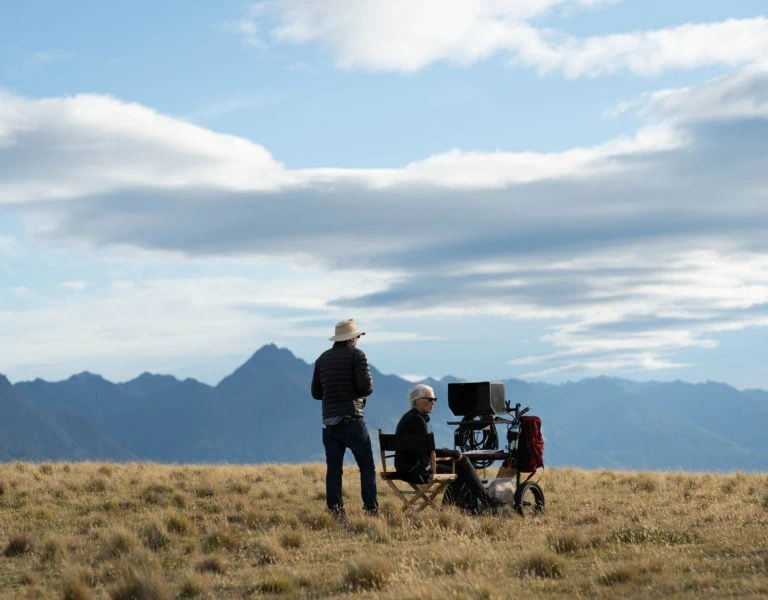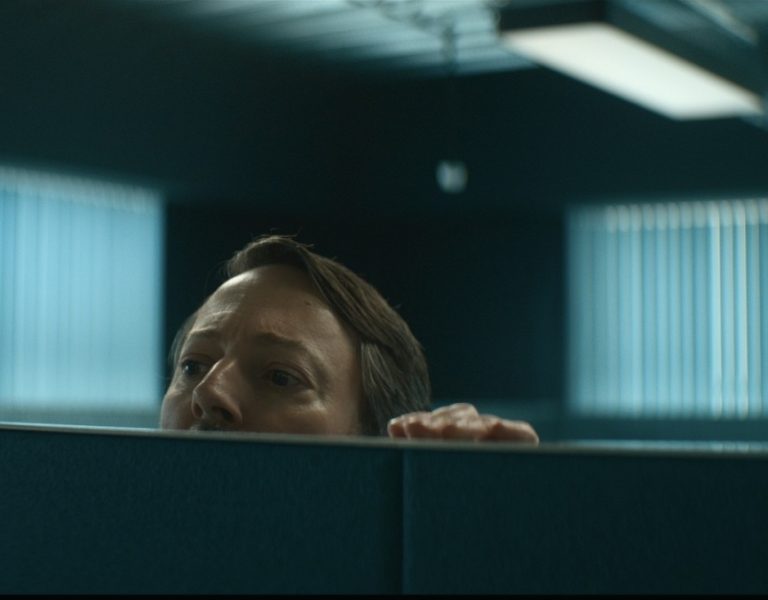MYSTERY AND MIRACLES
It was instantly evident to director Sebastián Lelio that the story at the centre of Emma Donoghue’s book The Wonder would make great cinematic territory. Exploring the possibilities with likeminded experts in their craft such as Ari Wegner ACS helped elevate the tale to new cinematographic heights.
It was the “very translatable cinematic energy” of Emma Donoghue’s 2016 book The Wonder, that made an impact on Chilean director Sebastián Lelio (A Fantastic Woman, Disobedience)when he was approached to direct the screen adaptation by producers Tessa Ross and Ed Guiney.
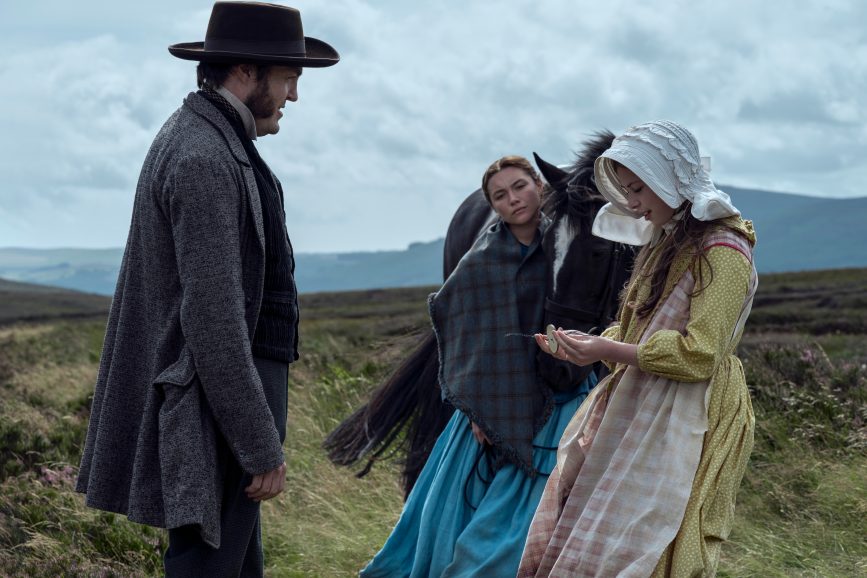
After successfully adapting Donoghue’s book Room for the screen, Ross and Guiney were drawn to the themes explored in The Wonder, spanning science versus religion, and the connection between a nurse, Lib Wright, and the young girl, Anna O’Donnell, who she will go to great lengths to protect. Lib (played by Florence Pugh) is called to a secluded Irish countryside in 1862, 13 years after the Great Famine. She has been hired by a committee of elders in the town to investigate the mystery of 11-year-old Anna (Kíla Lord Cassidy) who seemingly has not eaten for four months. When Anna’s health deteriorates, Lib embarks on a mission to unearth the truth.
“She [Lib] cares so much for the girl, and she ends up doing the wildest things to save her. I think that’s great cinematic territory,” says Lelio, who became “slowly obsessed with the book” and could see much of the movie was already there on the page.
The director felt “very lucky to start exploring this world” after Donoghue had carried out a huge amount of investigation and research spanning from the 16th century to the 20th century. “The Wonder is a very strange story, but it is, in fact, inspired by fact, in that there were about 50 or 60 cases of so-called ‘fasting girls’ who hit the papers,” explains Donoghue who provided multiple drafts of the screenplay before Lelio also brought Alice Birch (Lady Macbeth, Normal People) into the fold to bring another new perspective to the script.
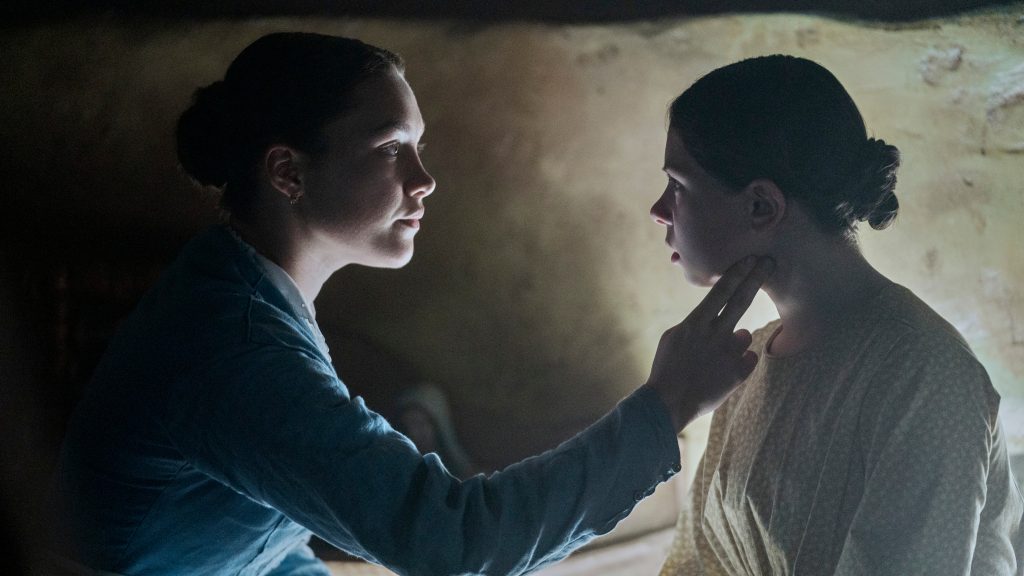
Fascinated by the territory being explored, Lelio also wanted the art of storytelling to be a focus. “The Wonder is about stories – the stories we tell ourselves and that we tell others in order to survive and keep on living,” he says. “I thought having these little gestures here and there, saying it’s all artifice and it’s all story, and you’re believing in it, and it’s unavoidable because that’s our way to inhabit the world, through narrative. That was just really exciting.”
To help him craft a production with storytelling engrained throughout, Lelio collaborated with Ari Wegner ACS (The Power of the Dog, Zola, True History of the Kelly Gang). One way in which Lelio wanted to experiment with storytelling techniques was to introduce a modern-day framing device to the 19th-century tale. This sees the audience enter and exit The Wonder through a film studio, pulling back the curtain on the magic of moviemaking.
“Those bookends were really important, and we knew we wanted each one to be one shot,” says Wegner. “The layout of the sets within the studio also required delicate planning, as the studio itself was going to be the set for those bookends. We had quite complex moves planned for each bookend, involving moving into and out of sets, wanting certain other sets in the background, or not – and once construction began, obviously there would be no tweaking their positions. So we pre-visualised that layout very precisely, with the camera movement being the driving factor.”
Longer camera moves such as these were saved for significant moments, including one of Wegner’s favourite shots which introduces Anna. It follows Lib full body, becomes a wide of the room and ends on a tight close-up of Anna’s face as she looks up. “I love shots like that because it’s a single shot, but it’s got all the coverage you would have otherwise, just linked together,” says the cinematographer. “It relies on everything working perfectly all the way through and requires a commitment, but it hopefully sets the mood for the visual tension used elsewhere in the film.”
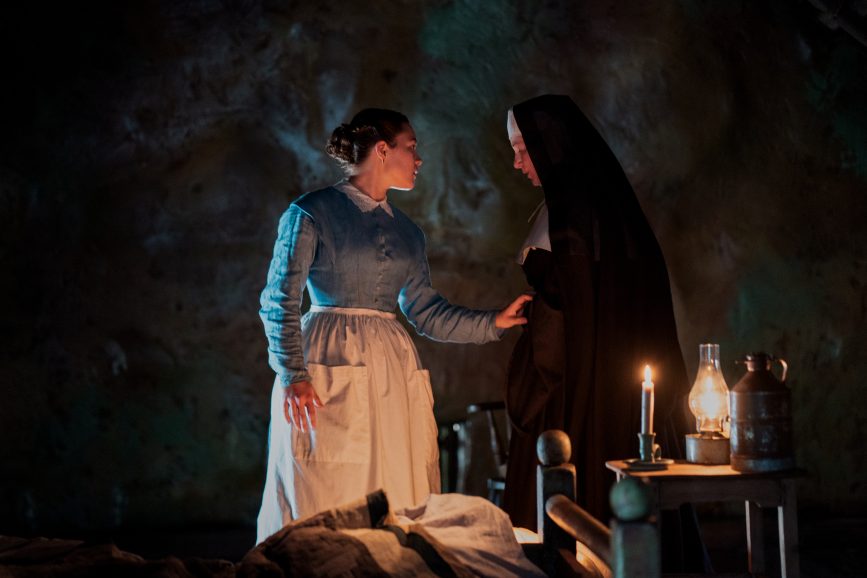
A natural unison
Wegner and Lelio met prior to creating The Wonder and had discussed working together on 2017’s Disobedience. “The stars didn’t align on that occasion but when this project came up, we met again and it all fell into place naturally,” says Wegner, who has always admired the director’s work including A Fantastic Woman (2017) which she commends as a film that “really stays with you”.
“The Wonder is what you hope for as a DP: a really exciting script with a wonderful director,” adds Wegner, who read the book prior to joining the production. Much to the cinematographer’s delight Lelio wanted a detailed prep period to precisely plan the shoot. They set aside every morning for prep, storyboarding uninterrupted and discussing creative and practical aspects of the shoot.
During this period one aspect considered was the restricted access to Kíla Lord Cassidy who, due to her age, could only be on set for three hours a day. This was factored in when planning while ensuring no parts of the film would feel visually rushed. “As Sebastian has made so many films, he knows himself well as a director, which is hugely exciting for me,” says Wegner. “Very early on, he said his happy place was 10 setups per day, and with 39 shoot days we could quite easily see how many setups we had to make this film. That was our “shot budget” so to speak.”
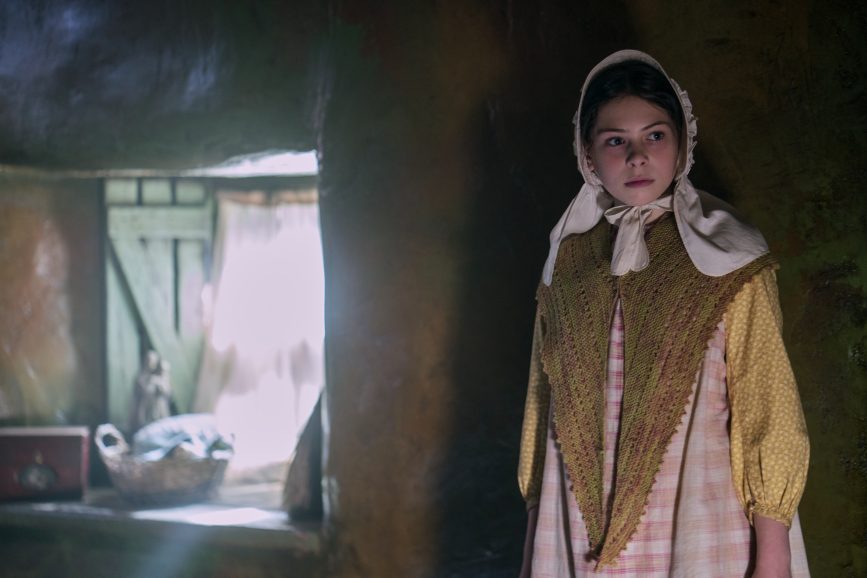
Keeping to that number, the pair roughly sketched every frame, before taking photos of each board on the locations in County Wicklow, Ireland. With Sebastián playing all the characters and Wegner taking the photographs, these images became the working document for themselves and the crew. “By the end of prep, we had photo boards for every shot – this coupled with our ten setups a day rule, we felt like we had a viable plan that could accommodate Kíla’s hours, locations moves and a little bit of buffer for the unexpected,” she adds.
Many reference photos from the period the story was set were examined. “The vast majority of those photos were black-and-white, so that allowed for some creative licence when it came to what the colour version would be,” adds Wegner. “And we wanted to make a colourful film, even though thematically the story is quite dark.”
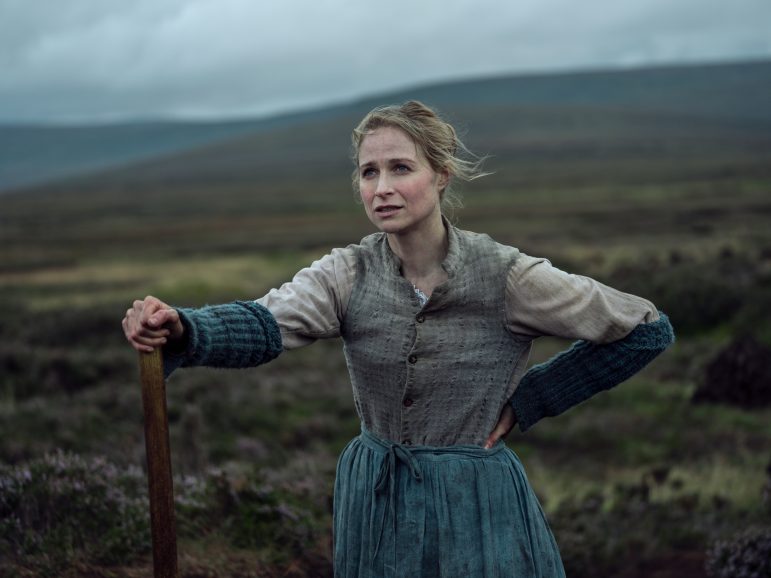
The filmmakers knew the topics being explored could be hard-hitting and felt this would not need to be heavily underlined in the visuals. “We wanted to find a way to inject colour and life wherever we could, and to avoid the film being too visually depressing,” continues Wegner. “The Wonder is also a story about a potential miracle and Lib is very full of life and energy, so we wanted colour to play a big role – such as Lib’s vivid blue dress, the green walls and the vibrance of the fire light.”
While wanting the film to be colourful, darkness still needed to exist, partly because large windows were not common during the period the film is set, and they wanted to preserve the historical accuracy of the architecture. The filmmakers also examined how animals could be incorporated into the visual language as Lelio and Wegner believe they add a tangible element that feels alive.
“We also did a lot of planning about curtains, shutters, specific wall colours and how shiny they should be. The sets were designed with these kind of lumpy, shiny green walls so they would appear both green and golden in the parts where they reflected the lamp and firelight.”
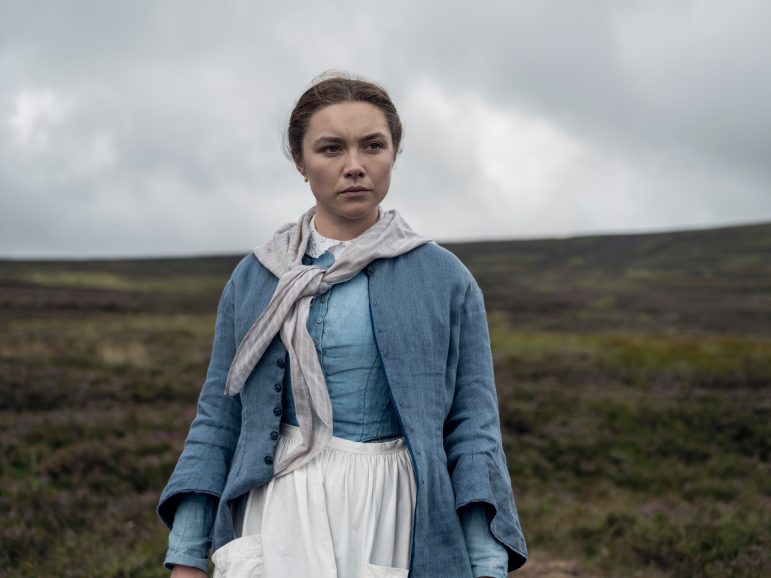
Supporting the craft
Shooting on film was considered but, due to shooting with a child actor, it was decided that this approach could add pressure when working on a tight schedule. The choice was made to lens the film using the ARRI Alexa LF, partly because many sequences would be shot in low light and with available light at dusk, including some dusk for night, so the couple of extra stops of sensitivity offered by the Alexa sensor made it an appealing choice. “Sebastián also likes to roll between takes, giving notes while we keep rolling, to preserve the moment and keep the room focused,” says Wegner. “We didn’t feel this would have been practical if shooting on film.”
Although she loves the Alexa look, Wegner did not want the film to look digital. With this in mind, early in prep the cinematographer and Lelio explored the idea of shooting digitally, carrying out a film intermediate, before coming back to a digital finish. Through DFD (digital-film-digital) – Cinelab’s analogue intermediate process – the digital files were transferred via ARRILASER onto Kodak 250D. The film was then processed and scanned back to digital.
“It was a new and incredibly exciting process for Sebastián and I,” says Wegner. “Adrian Bull, CEO at Cinelab, was on that journey with us from the early tests in prep and the lab team were very dedicated to getting the look we were after. I had faith it would deliver a really interesting result and I’m so happy with how it turned out.”
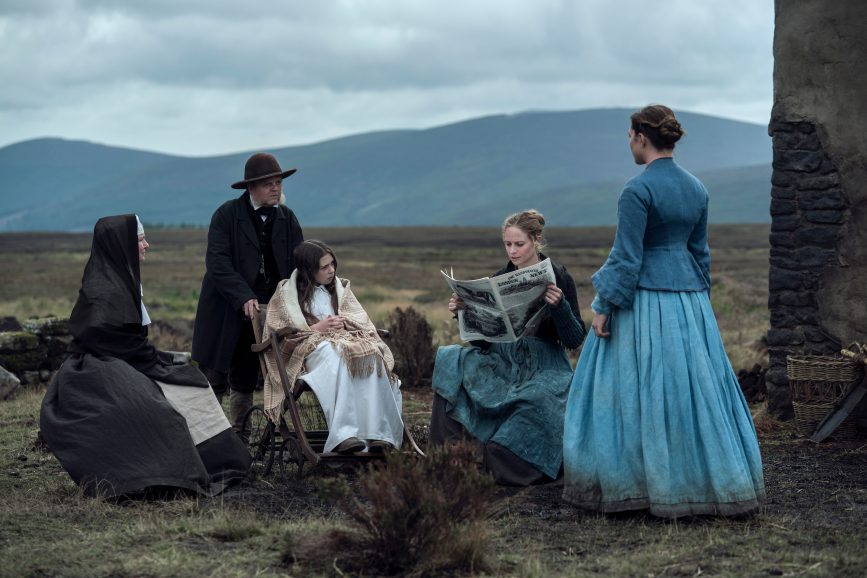
The DFD formed a large part of the grade and post process too which saw close collaboration with colourist Vanessa Taylor at Dirty Looks and post supervisor Deborah Harding. First the film was graded digitally by Taylor, working with a LUT to emulate the film process which was made following the testing. The emulation was then removed, and the footage was put through the film process before more grading was carried out to balance the visuals.
“I love the grade – it’s one of my favourite parts of the process,” says Wegner. “Vanessa is amazing to work with – finding the right amount of colour to use, where to put those colours, and how dark to go.”
The cinematographer is also grateful to Netflix for their support of the DFD process and trust in her and Lelio when they made the choice to go down that route. “Netflix’s faith that the process would add something really special was fantastic,” she says. “When I watch the film now, I’m so pleased we did it. I don’t think we could have achieved the same result just with digital.”
As well as learning from and adapting techniques learnt on previous productions, some different approaches were adopted. For example, when lensing Jane Campion’s The Power of the Dog (2021), Wegner shot a set on stage with huge windows and her and Campion decided the landscape outside should be visible through them. When filming The Wonder the small windows meant that “seeing out of them wasn’t key for us – we felt the house should feel more like a cave and almost becomes a prison you enter. Each time Lib’s on a shift, she’s in this little box with Anna – just two people together in the room,” says Wegner.
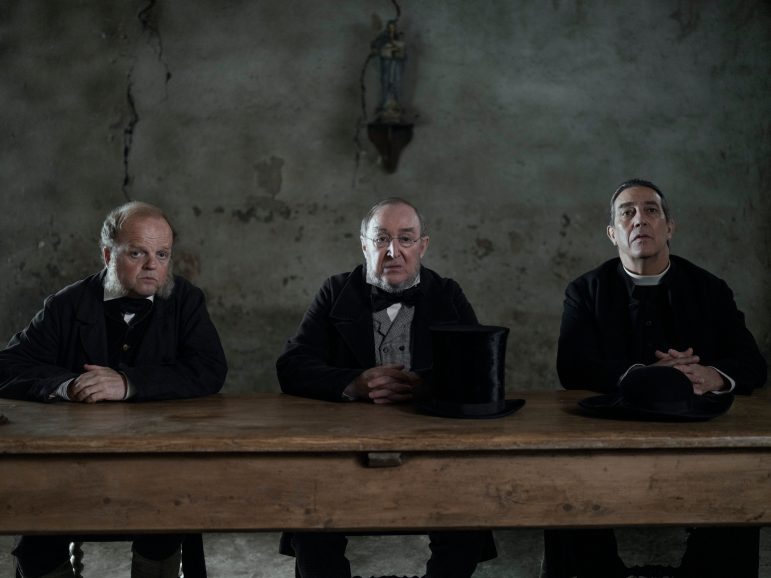
Blessing and responsibility
Following a location scout a year prior to shooting, Lelio selected many of the locations before Wegner joined the project. For the key location of the spirit grocery where Lib stays, production designer Grant Montgomery and Lelio discovered a café in the village of Redcross, County Wicklow, a region south of Dublin.
“I looked at Sebastián and said, ‘Are you thinking what I’m thinking?’” recalls Montgomery. “We walked through the whole location. It was a stroke of huge luck to get something that allowed us to have a three-sixty universe, as you call it. We took over and then converted. It allowed us to have all those multiple sets interconnected. So, you could move from upstairs in Lib’s bedroom in the spirit grocery, down the stairway, into the dining room, into the bar, into the front of the grocery, out into the yard and into the mortuary. It allowed you that complete universe because to split it just would have been difficult for Sebastián who has a very free-flowing aesthetic of shooting.”
Wegner commends Montgomery and his team for the transformation during which they “textured every wall and every surface and laid stones on the floor and to the façade. There’s something really special about a real location. Even if extensive work needs to be done to it, when it’s a complex structure like that it’s always more real than something you would build.”
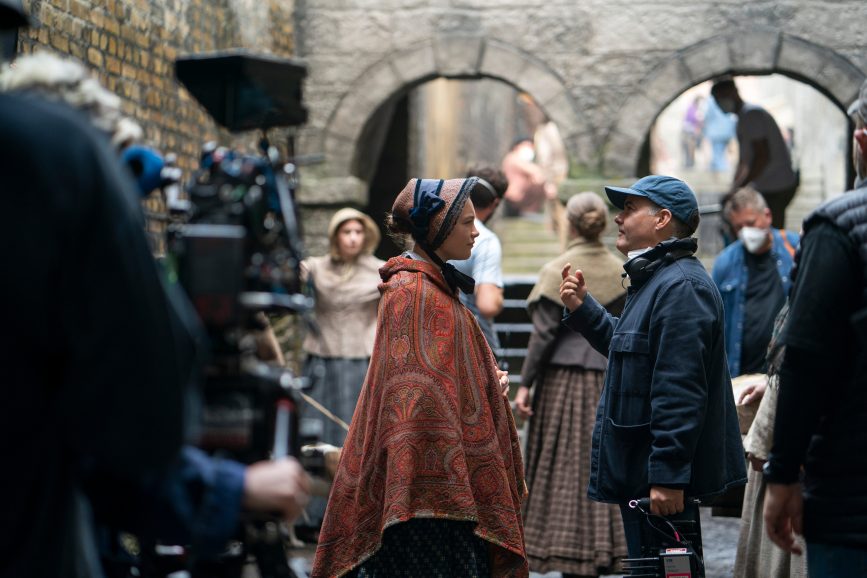
The O’Donnell’s house, where most of the watch takes place, was built at Sally’s Gap in County Wicklow. While the exterior of the cabin was on location, the interior was shot on a stage in an aeroplane hangar just outside Dublin. “That was a planning process for us all that we came to via the shot listing. Early on, Sebastián had a revelation that the O’Donnell House should have an upstairs – whereas in the book and original script, it’s a single-storey building. This allowed the bedroom set to be so much bigger and created separation between that space and the rest of the house,” says Wegner.
Shooting in beautiful locations such as County Wicklow was a “blessing as well as a huge responsibility” for the cinematographer. “Looking at it from afar, the landscape looks a brown and greyish green, but when you get up close there’s a huge range of colours, so many different greens and the violet of the heath,” she says. In keeping with the ambition of “not wanting to make a film with a drab colour palette”, they set out to make the landscape feel alive.
“It’s such a stunning environment with rolling hills and peat that was unique visually,” she says. “It’s also a very unusual almost alien landscape with very spongy ground which presented its own challenges when it came to laying dolly track and everything moving under your feet.”
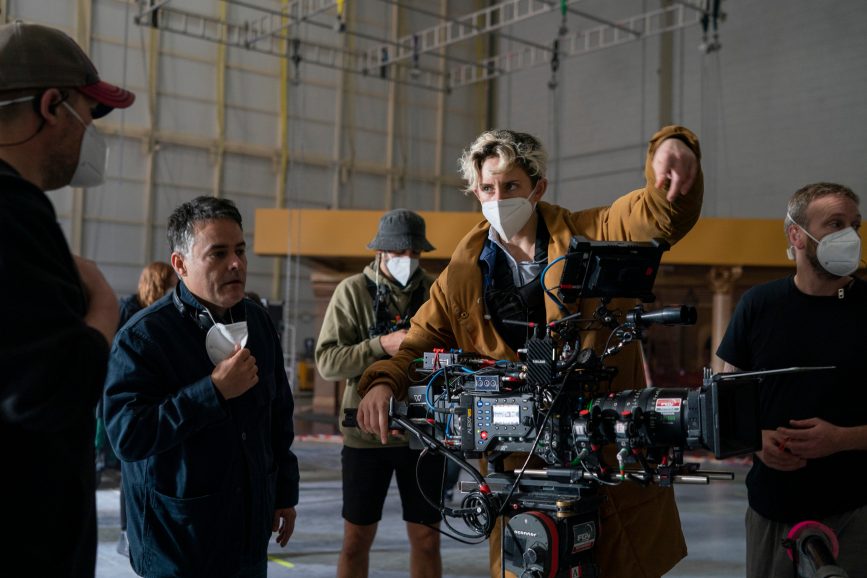
Key grip John Connon and his team worked tirelessly to ensure obstacles Wegner encountered when working in a new location could be conquered. “Looking at the landscape, I wondered how on earth we could lay dolly track over such undulating, spongy ground – but for locals such as John, it was no problem to achieve a beautiful long track – he and his team were incredible,” says Wegner.
Guaranteeing the landscape and characters came alive on screen was accomplished through carefully choosing which lenses to use when, helping avoid losing a character’s emotion. “We meticulously selected when to be wide on Lib to emphasise her aloneness – or when to be tight to notice what she is thinking – for this film we tended to use wide lenses for the tight shots, and longer lenses for the wides. What’s nice about a long lens in a vast environment is you can have a character in foreground and still have the landscape feel big and present. In one particularly important moment for Lib, we used a long zoom-in, which hopefully allows you to feel her aloneness as well as what she is processing.”
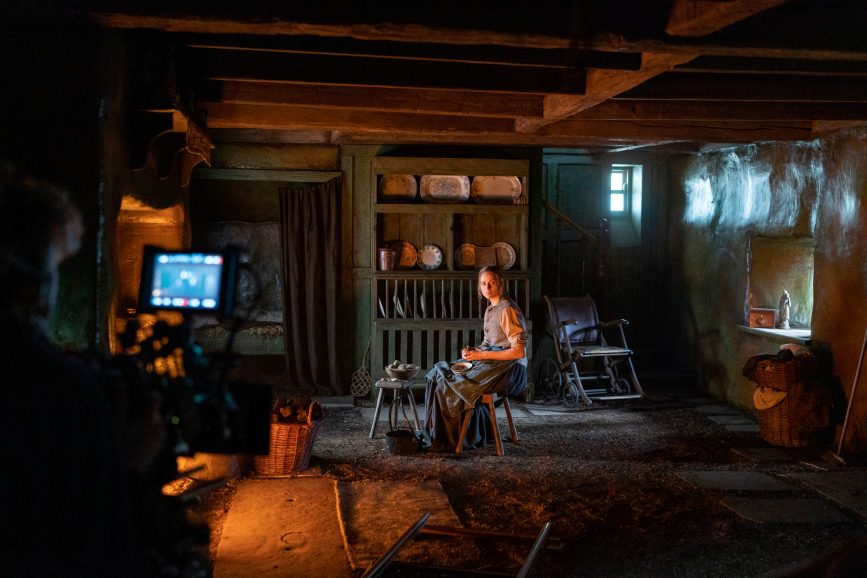
Wegner is pragmatic when choosing lenses and although it may have been tempting to use a vintage lens for a period film, she looked at “the bigger picture which was we were shooting full frame on Alexa LF, often in low light, with a young actor, and on a tight schedule. I didn’t want the lenses to add additional challenges or have to work around the limitations of a lens.”
Having shot on the Cooke S4 in the past, Wegner opted for another lens in the company’s arsenal – the S7 – which she found to be a “beautiful and rock-solid lens set offering amazing minimum focus”. Two cameras were often used for sequences that were emotionally intense or when there were time limitations due to Lord Cassidy’s available hours. Operating alongside Wegner was Mick O’Rourke who also shot Steadicam while Simon Culliton took on focus pulling duties on A camera, and Louise MacEllin on B camera.
“It worked really well which was also down to the extensive planning,” says Wegner. “If you’re going to shoot a scene with two cameras it will really change your lens choices, lighting decisions, and schedule, so for me successful B camera is part of the DNA of a scene from the beginning.”
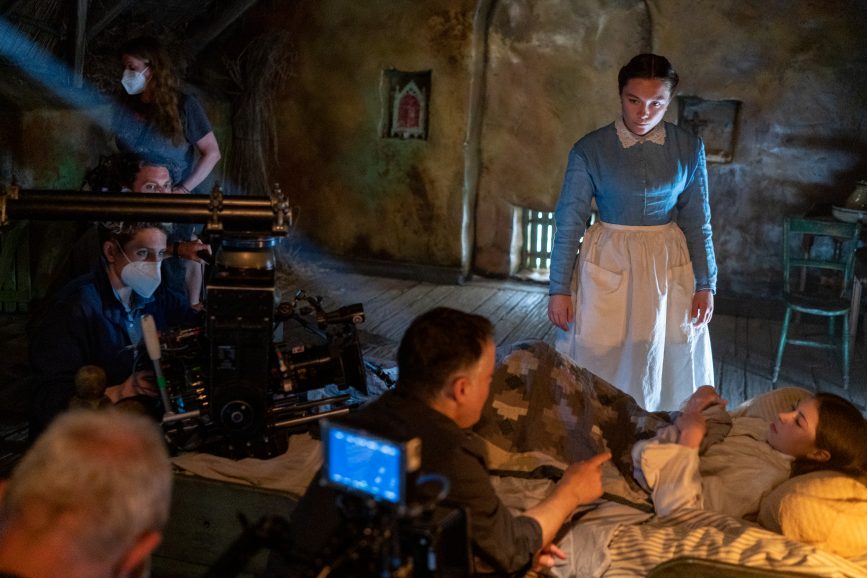
Emotional connection between Anna and Lib was paramount and achieved through keeping the camera inside their conversations as much as possible. “With this type of shot, we tried to get as close to their eyeline as we could, on a fairly wide lens, ideally avoiding over-the-shoulders” says Wegner. “Obviously this is rarely going to work in a two-camera set-up, so these were almost always single camera shots. That said, when shooting the confession scene, a long and emotionally gruelling scene between Anna and Lib, we really wanted to shoot two cameras to capture both actors’ performances simultaneously – as well as being inside the conversation.”
In order to achieve this, they ended up locking off the cameras, allowing each camera to be in the background of the other’s shot. “In the rushes, The A camera was in the B camera shot and the B camera was in the A camera shot – we then used a clean plate to remove the cameras in post,” says Wegner. “This allowed us to prioritise the actors as well as preserving the concept of being inside their conversations – we wanted to experience what Lib was seeing rather than watching her seeing something.”
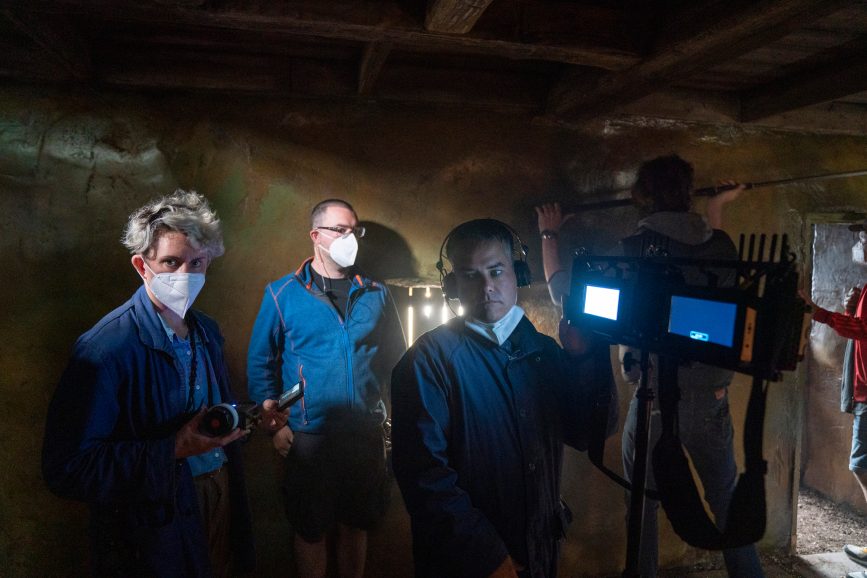
Atmospherically dark
Working with Garret Baldwin – a gaffer who Wegner considers “a brilliant artist in light” – was a joy. To light the sets, they used predominantly LED fixtures including ARRI SkyPanels and Astera tubes, controlled via iPad, which was valuable when working at speed while also needing to maintain delicacy of colour temperature. They also worked with hard lights, such as HMIs when they needed to create hard sun.
Due to the schedule and Lord Cassidy’s availability, in the morning Wegner often shot scenes featuring only the adults and would then film Lord Cassidy’s shots separately later in the day. “Making changes quickly so we could return to a previous set-up we’d been shooting was essential,” says Wegner. “Working with LEDs and the iPad avoided the extra burden on Garret and I when needing to precisely recreate set-ups day after day.”
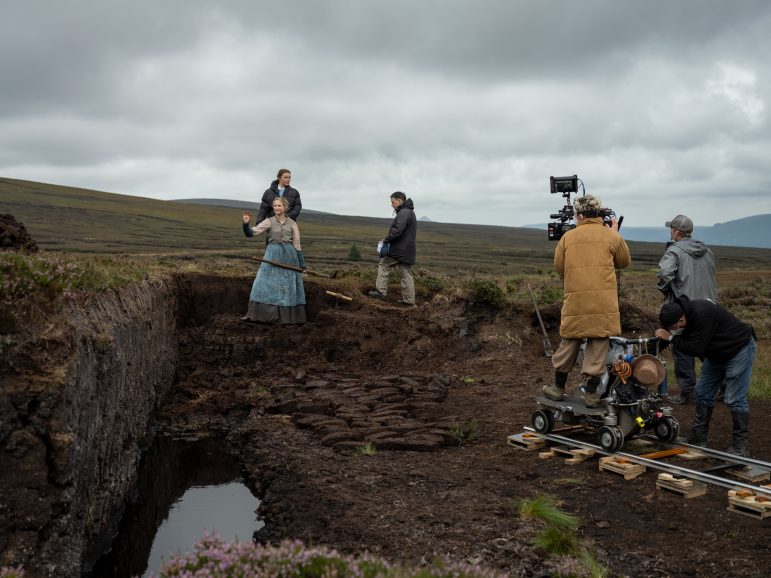
Day exteriors were predominantly shot using natural light and night exteriors were a combination of HMI and SkyPanels, with some larger fixtures such as Maxi Brutesfor fire effects. Baldwin also created flicker fireboxes from exposed household tungsten bulbs with controllable flicker rate. While LED is a powerful tool, Wegner believes “there’s something about a bunch of small tungsten fixtures which does a really good job at creating fire effects”.
Whenever shooting fire, Wegner also worked with low contrast filters, which she often uses to bloom the highlights of exposed sources. “An exposed source like a candle, flame or bare bulb is one of the biggest challenges for digital and I like what the low contrast filter does. It’s not a one-stop shop solution, but it’s one of many things that can help.”
The cinematographer endeavoured to avoid the interiors feeling over lit, however tempting it may be “to see all the exceptional actors clearly”. For Wegner, seeing their eyes is key, especially when shooting dark photography: “Eye light is one of the hardest things to perfect but without it you can lose all the great work the actors are doing. I love shooting scenes that are atmospherically dark, but you’re not visually lost either.”
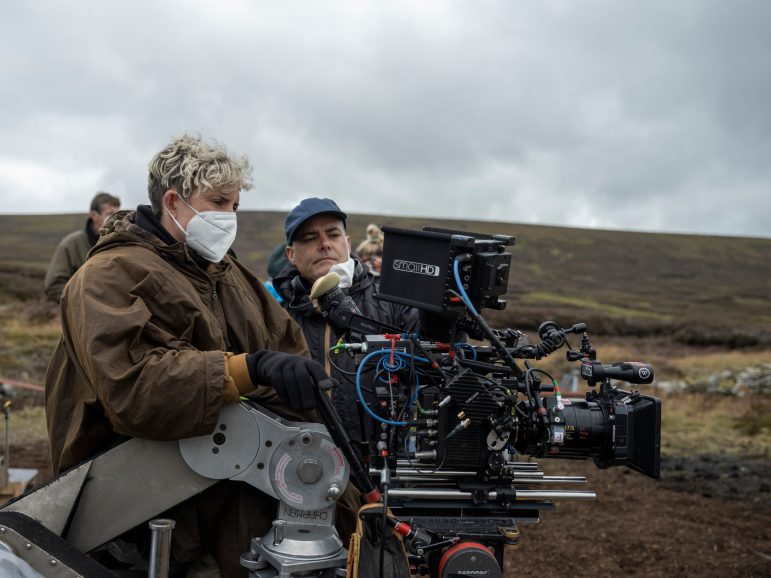
While there was not a precise plan for which scenes would be darker, the filmmakers aimed for the interior spaces to be quite dark, even in the daytime which led to uplighting techniques being adopted. “Grant Montgomery suggested a series of small low windows in the upstairs set – which got me very excited. When a window is at floor level, inevitably the light is going to be coming “up” on to the actors. Many people associate uplight with horror, but I actually find it quite angelic, especially when it is soft. We wanted to shoot Anna like an angel and to enjoy the ambiguity of whether there was something special about her, or whether she was just a regular child.”
Through lighting techniques such as these, the cinematographic craft aided the storytelling and fulfilled Lelio’s vision. “I remember, while shooting the film, looking through the camera and the monitor, and being so grateful because the film has this strength in terms of its visual dimension,” says the director. “That, of course, is the coordinated work between production designer and costume designer and camerawork. Ari Wegner’s contribution is essential. The film has this visual power. She was a great ally, and a great co-creator. She’s an extremely refined artist, and I think she helped elevate the film to a new level.”
